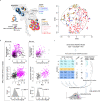Artemisinin resistance in the malaria parasite, Plasmodium falciparum, originates from its initial transcriptional response
- PMID: 35347215
- PMCID: PMC8960834
- DOI: 10.1038/s42003-022-03215-0
Artemisinin resistance in the malaria parasite, Plasmodium falciparum, originates from its initial transcriptional response
Abstract
The emergence and spread of artemisinin-resistant Plasmodium falciparum, first in the Greater Mekong Subregion (GMS), and now in East Africa, is a major threat to global malaria elimination ambitions. To investigate the artemisinin resistance mechanism, transcriptome analysis was conducted of 577 P. falciparum isolates collected in the GMS between 2016-2018. A specific artemisinin resistance-associated transcriptional profile was identified that involves a broad but discrete set of biological functions related to proteotoxic stress, host cytoplasm remodelling, and REDOX metabolism. The artemisinin resistance-associated transcriptional profile evolved from initial transcriptional responses of susceptible parasites to artemisinin. The genetic basis for this adapted response is likely to be complex.
© 2022. The Author(s).
Conflict of interest statement
Authors declare no competing interests.
Figures




References
-
- World malaria report 2019. Geneva: World Health Organization; 2019. Licence:CC BY-NC-SA 3.0 IGO.
Publication types
MeSH terms
Substances
Grants and funding
LinkOut - more resources
Full Text Sources
Molecular Biology Databases

